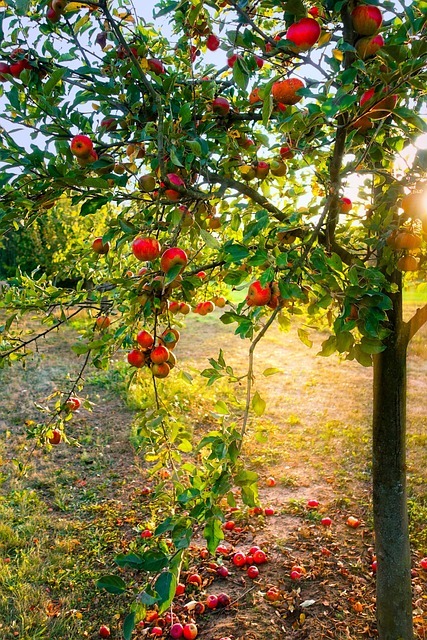How Rootstock Choice Affect Apple Trees Growth and Adaptability

When it comes to cultivating a thriving orchard or even a single backyard fruit tree, one of the most critical decisions lies beneath the surface—literally. The choice of rootstock, often overlooked by novice gardeners, plays a pivotal role in determining not only the size and productivity of a fruit tree but also its adaptability to various environmental conditions. For those looking to buy fruit trees, understanding the importance of rootstock is essential for long-term success in gardening.
Rootstocks are the unsung heroes of fruit tree cultivation, influencing growth rate, disease resistance, and tolerance to different soil types and climates. While the scion, or the grafted top part of the tree, determines the variety of fruit produced, it is the rootstock that provides the foundation for growth. This relationship between the scion and rootstock can make or break the success of a fruit tree, whether it’s an apple, cherry, plum, or pear.
Rootstocks and Their Role
Rootstocks are not a one-size-fits-all solution. They are carefully bred or selected to provide specific characteristics that complement the fruiting variety. For instance, some rootstocks are chosen to control the size of the stepover apple trees, allowing gardeners to cultivate dwarf or semi-dwarf trees in smaller spaces. Others are selected for their ability to thrive in certain soil conditions or to withstand pests and diseases common in particular regions.
A nursery specialist from CRJ FruitTrees emphasizes that “choosing the right rootstock is just as important as selecting the fruit variety. A well-matched rootstock ensures the tree can adapt to the local environment, reducing the need for intensive care and improving the likelihood of a fruitful harvest.” This expert advice highlights the necessity of considering rootstock when planning a garden or orchard.
Types of Rootstocks and Their Characteristics
Different fruit trees require different types of rootstocks, each tailored to meet specific needs. Here’s a closer look at some common types:
Apple Rootstocks
Apple trees are among the most widely grown fruit trees in the UK, and their rootstocks are categorized by their vigor. The M27 rootstock, for example, produces very dwarf trees, ideal for container gardening or small gardens. M9, another dwarfing rootstock, is slightly more vigorous and often used in commercial orchards for its early fruiting capabilities.
For those seeking more substantial trees, MM106 provides a semi-dwarf option, offering a good balance between size and productivity. Finally, the MM111 rootstock is known for its resilience, thriving in poor soils and providing a sturdy foundation for larger apple trees.
Pear Rootstocks
Like apples, pear trees also benefit from specific rootstocks. Quince rootstocks, such as Quince C and Quince A, are popular choices for controlling tree size and promoting early fruiting. Quince C produces smaller trees, ideal for intensive planting, while Quince A offers a semi-dwarfing effect with slightly larger trees.
For gardeners in colder regions, some pear varieties may be grafted onto Pyrus communis rootstock, which provides greater cold hardiness and adaptability to heavier soils.
Stone Fruit Rootstocks
Stone fruits, including cherries, plums, and apricots, require different rootstock strategies. The Gisela series is widely used for cherries, offering options from dwarfing (Gisela 5) to more vigorous growth (Gisela 6). These rootstocks promote early fruiting and are suitable for a range of soil types.
For plums and apricots, rootstocks like St. Julien A provide a balance of vigor and productivity. They perform well in a variety of soil conditions, making them a versatile choice for British gardens.
Environmental Adaptability and Rootstock Selection
One of the most significant advantages of choosing the right rootstock is its ability to adapt to local environmental conditions. In the UK, where soil types and climate can vary widely from one region to another, this adaptability is crucial. For example, gardeners in areas with heavy clay soils might struggle to grow certain fruit trees unless they select a rootstock that can tolerate poor drainage.
Rootstocks also play a key role in drought resistance. In regions prone to dry spells, opting for a rootstock with deeper rooting capabilities can help the tree access water stored deeper in the soil. Conversely, in wetter areas, a rootstock that prevents waterlogging and root rot is essential.
Moreover, rootstocks can influence a tree’s tolerance to temperature extremes. Cold-hardy rootstocks protect the tree during harsh winters, while heat-tolerant varieties help the tree endure unusually warm conditions. This adaptability not only supports the health of the tree but also ensures consistent fruit production year after year.
Disease Resistance and Pest Management
Another critical factor influenced by rootstock choice is resistance to pests and diseases. Some rootstocks have been specifically developed to combat common threats such as fire blight, crown rot, or woolly aphid infestations. By selecting a resistant rootstock, gardeners can reduce the need for chemical treatments, promoting a more sustainable approach to fruit tree cultivation.
For example, the MM106 rootstock for apples is known for its resistance to woolly aphids, a common pest in the UK. Similarly, certain plum rootstocks offer resistance to bacterial canker, a widespread disease that can devastate stone fruit trees.
The Impact on Fruit Quality and Yield
While rootstocks are primarily chosen for their impact on tree growth and adaptability, they also influence the quality and quantity of fruit produced. A well-matched rootstock ensures that the tree can sustain healthy fruit development, resulting in better yields and higher-quality produce.
For commercial growers, the choice of rootstock can have significant economic implications. Early fruiting rootstocks, such as M9 for apples or Gisela 5 for cherries, enable quicker returns on investment by producing fruit sooner after planting. Meanwhile, for hobbyists and home gardeners, the ability to harvest fresh, flavorful fruit from a manageable tree size is often a key consideration.
Practical Tips for Selecting and Planting Fruit Trees
When selecting fruit trees, it’s important to research not only the fruit variety but also the rootstock it’s grafted onto. Many reputable nurseries provide detailed information about the rootstock used for each tree, helping customers make informed decisions. For those looking to buy fruit trees, seeking expert advice from nursery specialists can be invaluable in ensuring the right match for their specific growing conditions.
Once the right tree is selected, proper planting and care are crucial to maximize the benefits of the chosen rootstock. Preparing the soil, ensuring adequate spacing, and providing appropriate water and nutrients will help the tree establish a strong foundation. Regular monitoring for pests and diseases, as well as pruning and training, will further support healthy growth and fruit production.
The Future of Rootstock Development
As the climate continues to change and new challenges arise in fruit tree cultivation, the development of rootstocks remains a dynamic and innovative field. Researchers and horticulturalists are constantly working to create rootstocks that offer even greater resilience, productivity, and adaptability. This ongoing progress ensures that gardeners and growers will have access to rootstocks suited to evolving conditions, supporting sustainable and successful fruit production for generations to come.
Conclusion
The choice of rootstock is a fundamental aspect of fruit tree cultivation that significantly impacts growth, adaptability, and overall success. Whether you’re planting a single tree in your garden or managing a commercial orchard, understanding the role of rootstock and selecting the right one for your needs is essential.
